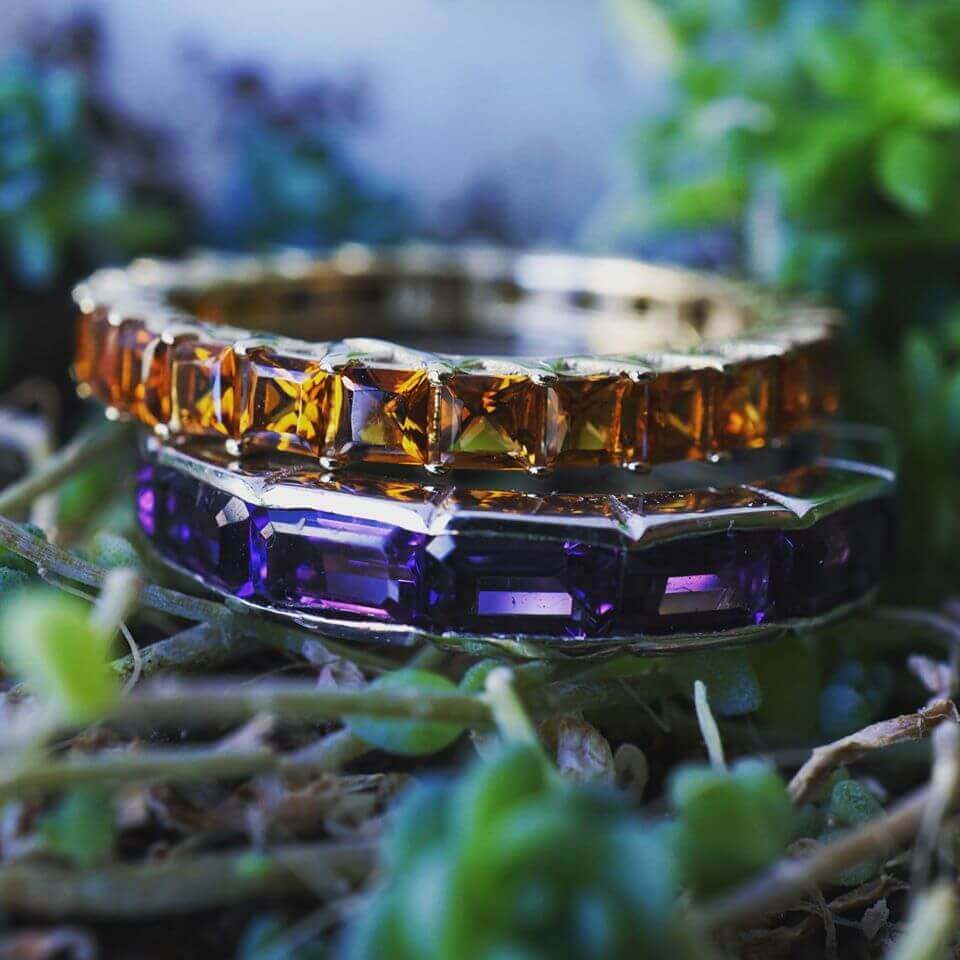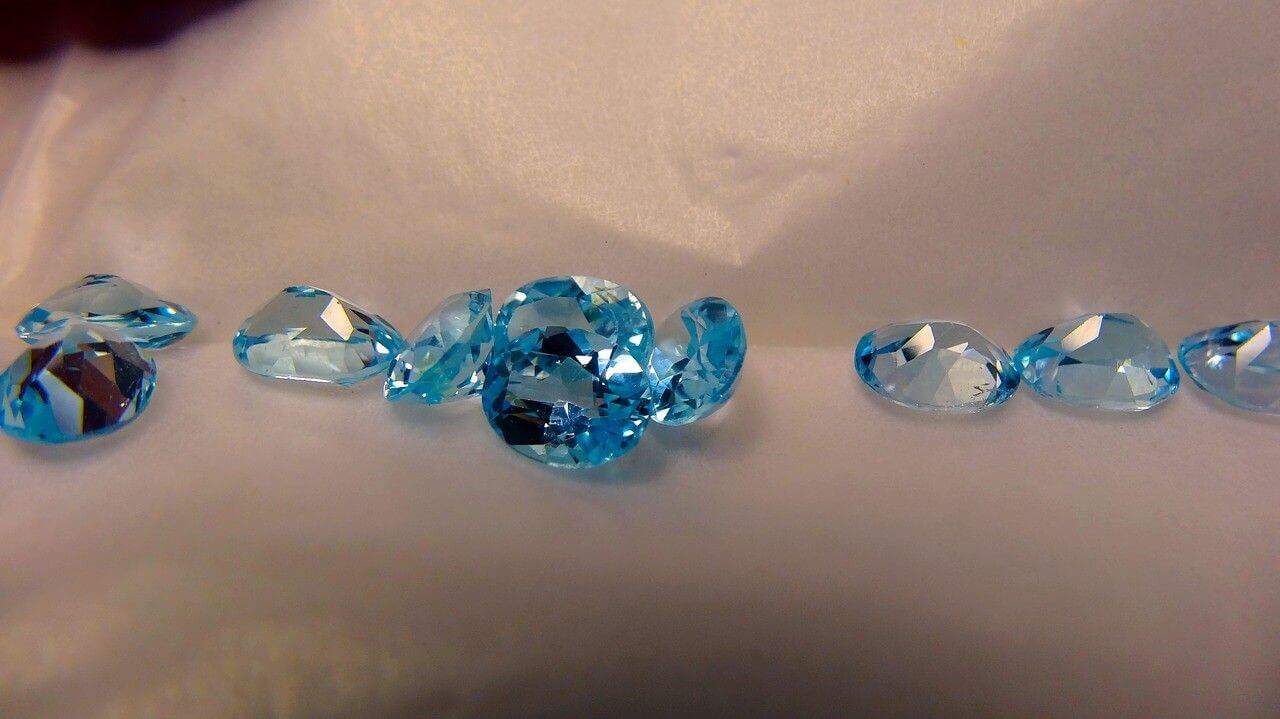The passionate red of ruby, the ethereal blue of sapphire, the clarity of a diamond… for millennia, colored gems have drawn us and captivated our imaginations. Read on to discover how gemstones get their color and the treatments that are used to enhance their beauty.
It’s All Elemental
In nature, colored gems usually form as a long-term result of a volcanic eruption. In this transformational event, minerals are thrown together underground and gradually metamorphose into exquisite gemstones when subjected to the right amounts of heat, pressure, and time.
As you may have suspected, the color of most gemstones develops thanks to the presence of certain minerals in its chemical makeup. Join us as we examine some familiar gems that change their color because of a mineral variation.
How Quartz Gemstones Get Their Color

Quartz is one of the most common minerals in the silicate family and is simply made up of silicon dioxide (SiO2). If you’ve ever searched along a dried-up river bed, it’s likely that you would have found some white or colorless quartz among the rocks and pebbles.
Three of the colored gems that we use here at AZEERA come from this common mineral family and reach their iconic colors through a mixture of chemistry and man-made treatments. For example, the rich purple of amethyst comes from impurities of iron as well as the natural irradiation from the rocks where it formed. Citrine — another kind of quartz — has its well-known amber to buttery yellow color because of colloidally suspended hydrous iron oxide. Natural white and black onyx forms in the vesicles of lava and forms in banded layers of quartz and morganite.
Treated Quartz Gemstones
Both citrine and black onyx (chalcedony is a type of quartz) are colored gems that are frequently treated to achieve their signature colors — as they are found in less abundance in nature than their purple cousins. Citrine can be created by heating amethysts and black onyx can be made by chemically treating gray chalcedony to turn it into a rich, deep black.
How Corundum Gemstones Get Their Color
Another family of colored gems that we use at AZEERA is the corundum family — including ruby and blue sapphire. The formula for corundum is Al2O3 (aluminum oxide) and this turns red with the presence of chromium (to make ruby) or blue with the presence of titanium and iron. Essentially, the titanium is what makes sapphires blue and the iron content deepens the resulting blue color. Although red rubies do occur in nature, mined rubies are often heated to deepen the color, completing the natural formation process.
Our Other Naturally-Occurring Colored Gemstones
Aquamarine
Be3Al2(Si6O18)The light blue color of the beryl gemstone aquamarine comes from its unique iron content. This gem is frequently heated to achieve the sky blue coloring that we’re all familiar with.
Peridot
(Mg, Fe)2SiO4Similar to aquamarine, peridot also has its green color thanks to the presence of iron. Peridot is the green variety of the mineral olivine.
Garnet
Garnet is actually a group of colored gems that each have a slightly different solution. Within this group, there are two series: Pyrope-almandine-spessartine and uvarovite-grossular-andradite. The first series has Aluminum (Al) as its second element and the second series has calcium (Ca) as its primary element.
Of these minerals, the magnesium-rich pyrope (Mg3Al2Si3O12) and iron-rich almandine (Fe2+3Al2Si3O12) are typically found in the deep red that we associate with garnet. The other varieties of garnet can be found in orange, green, yellow, colorless, and even black!
Diamond
Made of pure carbon with a formula of C, a perfect diamond is naturally clear. In fact, the rare colored diamonds that we find in nature are actually a result of structural defects! In some cases, the displacement of carbon atoms causes certain spectrums of light to be selectively filtered. In others, extraneous mineral inclusions give the diamond its rare and beautiful coloring.
How our Treated Gemstones Get Their Color

The final category on our list are colored gems that achieve their coloring through a series of treatments.
Pink Tourmaline
(NaCa)(LI,MgFe,Al)9B3Si6(O,OH)31Part of the family of aluminum borosilicates, tourmaline occurs naturally in every color and presents with various chemical formulas depending on the variety. While pink tourmaline does occur naturally in the variety known as rubellite, most pink tourmaline gemstones have been treated with irradiation and heat to lighten and brighten their natural color.
Swiss Blue Topaz
Al2SiO4(F,OH)2Like most of the minerals on our list, topaz is a silicate mineral. In this case, it belongs to the aluminum and fluorine family. Colored topaz gems can be found in a wide range of colors, with light blue being especially rare. Typically, pale topaz is treated with high-energy electron or gamma radiation and is then heated until the popular Swiss blue color is reached.
Create Custom Gemstone Rings at AZEERA
Now that you’ve read the answer to the question “How do gemstones get their color?” you probably have a new appreciation for the intricate processes that go into creating each and every gem. Add to this that our gemstones represent the top 1% of rough material from around the world and you have a piece that is truly remarkable!
As you browse our collections of engagement rings, wedding rings, everyday rings, and cufflinks set with colored gems, we invite you to personalize your designs with the stone of your choice and to request a callback for personalized design advice. Every gemstone has its own unique glow that took just the right conditions to create. Discover your perfect gem at AZEERA today!

















































































